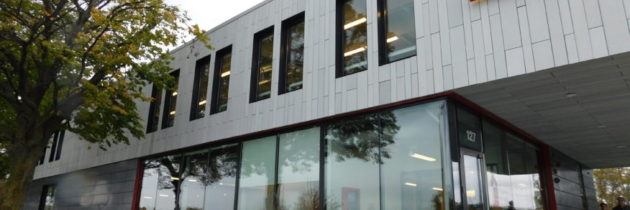Modular Construction Used to Build Harvard Life Lab
On November 3, 2016, Harvard University announced the opening of the new Pagliuca Life Sciences Lab. Located in Allston next to the existing Innovation Lab, the new Life Lab was built using accelerated modular construction. Triumph worked with leading modular fabricator, NRB, to build 34 highly specialized steel-framed modules in their state-of-the-art factory. Gregg Kelly, Triumph’s head of consulting services, coordinated the project with NRB, Harvard, Shawmut Design & Construction, and Shepley Bullfinch. Gregg spoke with Rusty Williams about the unique requirements and dynamics of this project.
RW: I’m pleased to welcome Gregg Kelly, head of consulting services for Triumph Modular. Triumph just announced a major project for Harvard. It’s called the Pagliuca Life Sciences Lab and it’s an expansion of their laboratory research space in Allston near their existing iLab facility in the innovation corridor. Congratulations Gregg on reaching that milestone. GK: Thanks very much. It was an exciting project, working with a great team between Harvard, the construction manager and architect. It was a nice experience.
RW: This is just one in a series of several projects that Triumph has done for high profile universities in New England. Is this a shift in direction for the company or a trend overall?
GK: Well, I’d like to think it’s probably a little of both. I think Triumph has over the past several years has recognized the need for a variety of space on private campuses, private schools, and the acceptance and use of this type of space by institutions such as Harvard, Tufts, Williams, and MIT has, in a way, validated the method. It’s certainly become more accepted and recognized as a viable option.
RW: Let’s dig into that. Why is modular a good option for these types of projects? And why would schools like MIT and Tufts and Harvard be looking to Triumph for a modular approach. GK: For a variety of reasons. I think the speed to occupancy is certainly a key consideration for many of these uses. Less disruption on the campus through the course of construction. The flexibility to add or reduce the size of a building and perhaps even relocate it. And then finally the option to lease is certainly an attraction as well.
RW: You mentioned that there’s less disruption. How much of the building is actually made somewhere else?
GK: Ideally we try to reach 60, 70 even 80 percent completion off site. The reason being that it limits the time on site at a typically much higher labor rates and of course the disruption to the surrounding community during the construction process. Ideally to get the full benefit of modular we generally look to get 60 to 80 percent complete offsite.
RW: And you mentioned time to occupancy was important. Can that be quantified — how much quicker is it than the traditional approach?
GK: The concurrent construction process is the key. While we’re constructing the building at a factory, all of the site improvements, foundations, and utilities are being completed concurrent to that factory construction. So typically the building is erected and completed, it’s not unusual for that to be within a three or four month period. In the case of the Harvard project, we were told that they were able to occupy probably a year in advance of what conventional construction would have accomplished.
RW: So that’s significant… RW: This project was out of the ordinary because it is a really high end science facility. Did that pose any special or unique challenges. GK: It certainly did in the MEP areas — the mechanical, electrical and plumbing areas — along with sprinkler, fire protection and so on. It had much more sophisticated systems as opposed to a typical office or classroom building. So that meant the coordination of those systems throughout the construction process was much more involved and detailed.
RW: How are things today? Is it being used by students and companies? GK: It is. Occupancy was at the end of October, beginning of November. As of this date there are 17 different occupants with 17 different projects going on in the building, which, I understand, is close to capacity. Full capacity is around 20 users. And that’s really just a function of the vetting process on the part of Harvard. They have people lined up to occupy. They’re just sorting through the applications.
RW: In other words, it has filled an immediate need.
GK: Exactly.
RW: It’s great to get an overview. Are there other points you want to make about how this project came together or what may be in the future? GK: I think that because this was a life science building with the complexities we’ve talked about with the MEP systems, this particular building was built in a static method, which is one of two different ways that these building are typically constructed. The other method is an assembly line process. The static build process ensured that things came together as specified. We knew that because it was 70% built offsite, that when it was removed from the factory and reassembled on site it was going to go together properly. So static is a specific method of construction in modular and certainly was of great value in this case.
RW: So it arrives and all of the high-end equipment, scientific testing, conduits or whatever they might have needed are all re pre-engineered to “click” together. I don’t know if click is the right word… GK: But that’s true. They’ve basically been constructed off site, disassembled and then reassembled at the project site and so we know they’re going to go together properly when it gets there.
RW: I really appreciate your time. Congratulations again on this project.

